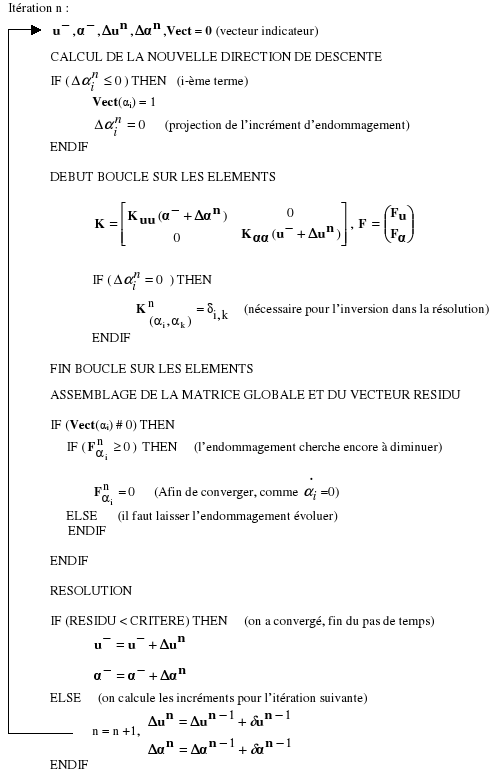3. Resolution methods#
If we exclude the unilateral condition of irreversibility of the damage, the Newton algorithm as currently programmed in the code is sufficient for the resolution. In our case, we must take into account the degradation of the material. For modeling GRAD_VARI, this constraint is managed locally, at each Gauss point, by projection onto the old value if it is a discharge behavior. Since the resolution of the criterion is no longer local with GVNO, it is no longer possible to perform this type of projection and irreversibility must be imposed at the global level.
Two resolution methods can then be envisaged with this modeling. It is either possible to work with a classical Newton, ensuring the projection of negative damage increments. Or with a « secant » algorithm which consists in setting the extra-diagonal blocks to 0 and therefore in considering the independent displacement and damage variables. This is equivalent to the alternating minimization algorithm in the case of quadratic behavior laws when moving and when damaged. This time, irreversibility is ensured by projecting negative damage increments.
In both cases, the resolution is carried out in three steps:
First, we are interested in the damage increments at each iteration. When the increment is negative, it is projected to 0, so as to respect irreversibility.
We build the stiffness matrix (only the diagonal blocks in the case of secant) and the internal forces.
Damage residues are defined by the complementarity relationship:
\({R}_{n}^{\alpha }={F}^{\alpha }{\mid }_{n}\Delta {\alpha }_{n}\)
With respectively: \({F}^{\alpha }{\mid }_{n}\ge 0\) and \(\Delta {\alpha }_{n}\ge 0\)
This involves looking at the sign of internal forces associated with the degrees of freedom of damage projected in Step 1. Indeed, if it is negative, we do not respect all the conditions imposed and we must keep the internal force as a residue. If this is positive the residue is then zero since the increment is zero.
More precisely, the resolution method, in the case of secant (block diagonal matrix), can be presented as follows:
